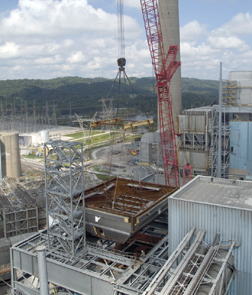 AEP CO Powerplants have made changes.
|
The change is expected to push more localities out of compliance with air-quality requirements, and could trigger the withholding of federal construction funds as well as retrofit projects at powerplants.
The new eight-hour standard, signed on March 12 by EPA Administrator Stephen Johnson, is the first revision of the ozone requirement in more than a decade. It tightens ozone’s highest permissible level from the current 80 parts per billion to 75 ppb. States have until 2010 to develop reduction plans.
Johnson says the new level, based on a review of current science on the effects of ozone on public health, is the toughest ever enacted in the U.S., but 85 counties still have not met the current standard, set in 1997. States and counties designated as “non-attainment” areas can face stiff penalties and have federal transportation dollars withheld until their air quality improves. Based on current monitoring levels, some 345 counties will not meet the new standard, Johnson says.
“That’s 260 more counties that now have to worry about having their transportation dollars withheld,” says Nick Goldstein, the American Road and Transportation Builders Association’s director of regulatory affairs. “These counties already had their long-term transportation plans put in place with the idea that the standard was [80 ppb], and now you’re changing the standard.”
Environmental groups and many congressional Democrats contend Johnson should have relied more on input from EPA’s own Clean Air Scientific Advisory Committee, which recommended the benchmark be set no higher than 70 ppb.
Industry groups say the standard should have remained 80 ppb. Electric utilities say they have already cut nitrogen oxide emissions significantly and will be hard-pressed to make additional cuts.
Pat Hemlepp, a spokesman for American Electric Power Co., Columbus, Ohio, says, “When you already have state-of-the-art emissions controls on the plants, if air quality still isn’t achieved, then you pretty much have to look elsewhere for additional reductions.”
Andy Byers, associate vice president in Overland Park, Kan.-based Black & Veatch’s energy division, says powerplants located near newly designated non-attainment areas may need to make emissions reductions for the first time. “Not everybody’s out of the woods yet,” he says.
he Environmental Protection Agency’s new, tougher standard for ozone seems to have pleased few outside the agency. There is criticism from industry groups, which argue that the new benchmark is too strict, and environmental organizations that contend it isn’t strict enough.

Post a comment to this article
Report Abusive Comment